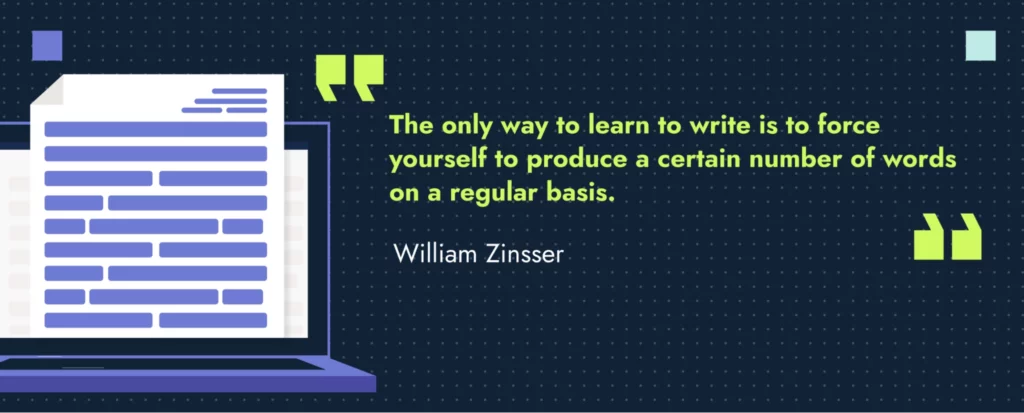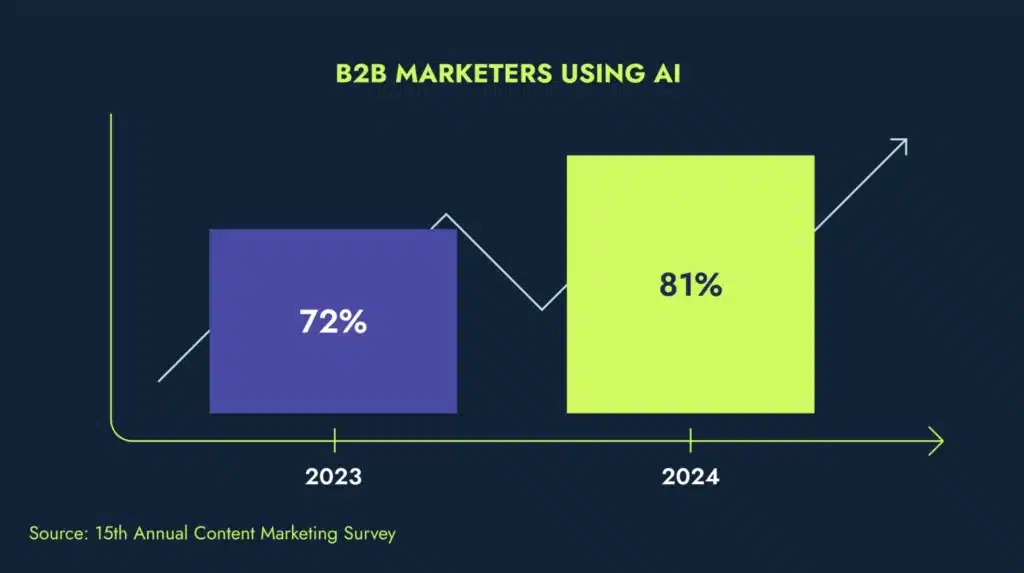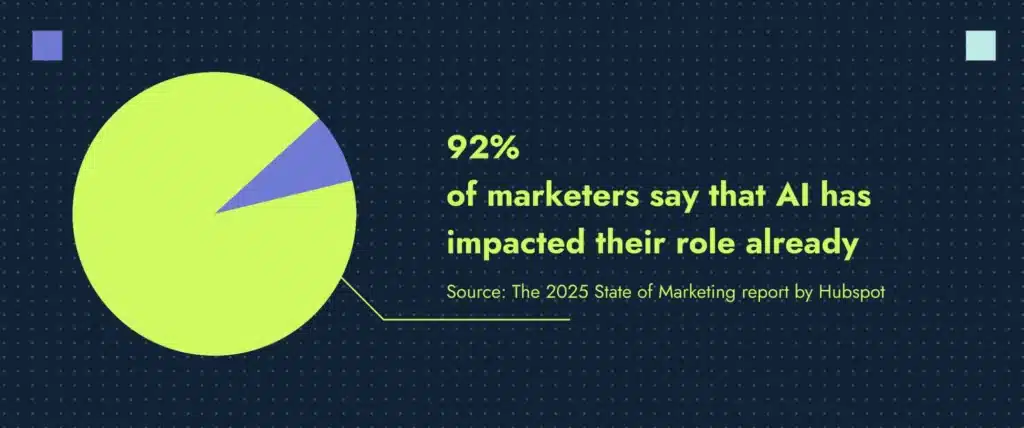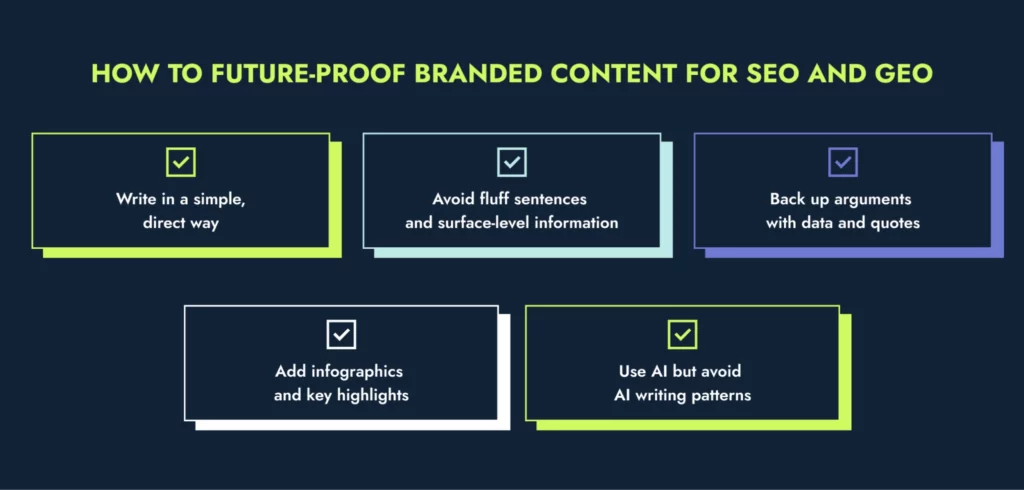We kicked off 2025 by making changes in how we write blogs for our B2B SaaS clients. And that’s just the beginning of a year that promises to keep shaking up content marketing departments.
Are writing jobs at risk with the rise of gen AI tools? Does SEO still matter? What can I do to trigger an AI Overview? Which content creation best practices make sense at this point? So many questions pop up in every meeting.
As the editor-in-chief of a top-performing content team that I have built from the ground up (and grown over the past four years), I’ve been in the trenches, working alongside our writers and SEO strategists to adapt, innovate and future-proof our roles in 2025.
Let me walk you through my vision for the future of content teams, starting with my own.
a🎯 Key insights for 2025:
- Content roles are not at risk — on the contrary, in this gen AI age, seasoned writers have an opportunity to become more valuable. But you need to leave your comfort zone. Embrace automation and change (or you’ll end up out of the market).
- Learn to navigate the pressure to use AI to output content faster while avoiding AI patterns that weaken your writing.
- Gain new skills and focus more on strategy over execution. Master the basics because the market is becoming unforgiving. There’s no room in a high-performing content department for professionals who fail to deliver in terms of time management, attention to detail and critical thinking.
- AI overviews appear as the new holy grail of search but the core principles of SEO remain the top priority: creating comprehensive and authoritative content written by humans for humans.
- Simple writing doesn’t mean simplistic. Be direct, precise and informative. Use data points, tables and infographics to explore topics in depth.
Does your content marketing department have room for junior writers?
I’m the first one to say to my team that generative artificial intelligence (gen AI) is not a threat but an ally. The truth? It comes down to skill level. Junior, inexperienced writers are at risk the most. After all, no one becomes a seasoned writer overnight. You learn to write by writing.
To quote William Zinsser:
📚 Go read: William Zinsser’s On Writing Well
To hone their skills, writers need practice and mentorship, which require time and investment. But can your content department afford that? Or even worse, does leadership actually see the value of content services? Many SaaS CEOs and CMOs are under the impression that anyone can do content with AI now. And depending on what your writing standards are, that’s a valid point.
Quality is the real challenge here — and it’s key to demonstrating the value of content as a strategic investment that shapes your brand perception and enables sales.
But let’s not be naive. We’ve seen it happen many times in the tech sector: during layoffs, digital marketing roles — especially those of content writers — were often the first ones to go.
While junior writers often make less than those with more experience, there’s a hidden cost if you account for the time senior staff spends editing (and often redoing) their work. That’s why hiring managers like myself often give more preference to professionals who can hit the ground running.
Finding your “unicorns”
You might want to invest in potential raw talent you can mold, but it requires patience, especially when you start seeing the same types of mistakes over and over again. It is not always a matter of experience and adequate training: there are people who can’t learn or don’t care enough. And sometimes you need to admit that you’ve made a hiring mistake.
So what to do when an individual’s potential may not translate into actual growth and contribution?
First of all, you need to be clear about the expectations, the pressure and the standards. As a Dale Carnegie’s survey reveals, 85% of high-performing teams say their goals are well defined.
I don’t hire writers who are not passionate about their craft. We only work with B2B SaaS companies. If you don’t like our topics, which tend to be complex, you won’t be able to hide your lack of excitement for too long.
Plus, no one wants to start a new job and realize they’re lagging behind their peers. It’s a constant blow to morale. An underperforming team member increases the workload for everyone else.
- You lose faith in the person’s ability to deliver, resulting in closer oversight.
- Team members might have to pick up the slack, leading to burnout.
It’s my job to protect my team, and I can’t do it by lowering the standards — especially because of the specialized nature of a B2B growth consultancy working with nuanced topics like B2B cybersecurity, supply chain software and fintech.
Ideal scenarios for junior vs seasoned writers
To not sound discouraging, depending on the type and size of your content department, you might indeed have room for different skill levels. Junior writers can:
- Be a great fit for handling more routine or less specialized content tasks — freeing up senior writers to focus on high-impact, strategic projects.
- Benefit from structured guidance. Content departments that are able to invest time in training and mentorship cultivate highly skilled writers over time.
But I’d avoid hiring junior writers in the case of:
- High-pressure, fast-paced environments: In organizations demanding immediate results and high-quality content from day one, junior writers will struggle to keep up. The steep learning curve and the pressure can hinder their development. Plus, not everyone wants to be a high-achiever.
- Specialized or technical content: If the writing requires deep industry knowledge or technical expertise (let’s say, cybersecurity content marketing), a junior writer may lack the necessary background. They can learn but it will require time investment.
- When content is a direct driver of revenue: If creating content is critical for lead generation or sales enablement, relying solely on junior writers might be risky due to misunderstanding of your ICP and pain points, lack of strategic insight and overall quality inconsistency. The same goes for an agency setting. Client dissatisfaction can lead to lost contracts, negative reviews and reputational damage.
With generative AI, your content department needs to raise the bar
With the increased adoption of AI in marketing, writing roles are at a crossroads. It’s my responsibility to assure my team that their jobs are safe and to avoid creating panic, but I also need to prepare them for the challenges and new skill development ahead.
AI writing is forcing a separation between two types of content creators:
- Those who can’t keep up with the pace, changes and standards — risking being left out of their jobs
- Those who embrace AI tools to become more competent and marketable
Here’s a breakdown.
When AI is a threat to writers 👎
There’s no sugarcoating here. For those who already struggle to create quality content, AI poses a threat. AI can generate grammatically correct, coherent text on a variety of topics (that are widely available for AI crawling), replacing writers who produce subpar work.
How does it translate into daily operations?
- If you can’t deliver proofread, error-free content that follows the brand style guide, you’re in trouble. Case in point: I just grilled one of my writers for delivering sloppy copy full of typos. We do have Grammarly Pro — and with the plugin on Google Docs, you see all the typos underlined in red. Delivering clean, polished copy is a basic expectation.
- If you only write surface-level content, you might not be needed. If you’re spending hours to produce a blog post that a chatbot can generate in seconds, you’re not adding enough value. Case in point: I had to let writers go in the past due to an inability to create contextual content that fits clients’ needs — a deficiency that becomes more apparent with the evolution of AI copywriting tools.
When AI is an enabler of good writing 👍
AI won’t replace good writers. Neither will companies stop hiring content pros. HubSpot’s State of Marketing report even lists content creators (along with social media coordinators) as the top priorities for recruiting in 2025.
For skilled writers, AI is a time saver. According to the Content Marketing Institute’s annual survey, 51% of B2B marketers using generative AI see fewer tedious tasks. For 45%, there are more efficient workflows and for 42%, improved content optimization.
You can focus attention elsewhere: on what truly makes the piece valuable, including unique voice, deep research, interesting angle and ability to connect with the audience. No wonder 79% of businesses surveyed by Semrush report an improvement in content quality when using AI tools.
As I tell my team, the expectation is to use AI to create resonating content — and faster.
The future of content creation is fast-paced
As head of the department, I’m the first to pressure our writers to increase productivity. Our content marketing team needs to stay competitive. Period.
Our clients expect us to cut down the hours. With automation, that’s the market expectation: improve not only speed but also quality. Imran Selimkhanov, our CEO, always makes it clear in our leadership meetings that embracing automation is not an option.
That doesn’t mean a blind adoption of AI, though.
When working with clients that have their own in-house or freelancer writers, we often have to challenge the notion that an intern with ChatGPT or Gemini can output all the content their brands need to succeed in search. It’s true they can produce branded content at scale — but here’s what some companies don’t want to hear: fluffy and superficial content that their interns can quickly create with AI tools won’t give the results they want.
Google has made it clear that it won’t tolerate the use of scaled content creation methods to manipulate search rankings. In fact, it has strengthened its spam policies to tackle mass content production, whether by humans or automation tools.
Still, everyone should use AI content automation to streamline the writing process. It might sound contradictory, but let me give you a rundown of what I call the AI paradox afflicting content departments.
Why content marketing teams face an AI writing paradox
Writers are pressured to use AI to write faster and boost productivity, but ironically, the very use of AI can lead to content that appears AI-generated: robotic, repetitive and generic.
These AI patterns are especially problematic in B2B SaaS writing, where you need nuanced understanding and deep context to create assets that truly resonate with your specialized buyer personas. If your audience is spending thousands or even millions of dollars in new software deals, they need to understand how your product solves specific pain points, fits into existing workflows and tech stacks and brings them a return on investment.
AI currently struggles to provide this level of detail and insight because the information it relies on — the vast pool of online data — often lacks the depth and specificity required for complex topics such as cybersecurity, govtech and fintech.
Just look at this chart showing the amount of AI content in Google search results.
I have seen different clients deliver us drafts for web search optimization with up to 80% of AI patterns. As I make it very clear to them: overreliance on AI writing is what puts SEO projects at risk.
🔖 Read this scaled content abuse policy from Google.
The best way to rank on search is to create unique content that stands out. Make sure to use tools that detect AI patterns (Grammarly, for example). Although these tools might not be 100% accurate, they help you identify excerpts for refinement. You don’t need to bring AI patterns to zero but cut them down as much as you can (5-10% top).
☝️ In case you wonder, this blog you’re reading has 0% of AI text patterns, per Grammarly.
Takeaway for brands: Avoid being flagged as spammy
What brands need to understand is that quality trumps quantity. Better to publish one comprehensive, long form content that has a good chance of ranking than to release three shallow pieces created in seconds by AI.
Let’s not forget that Google’s latest spam update puts a target on pages that attempt to make their way to the top of the SERP without actually bringing value to the reader. As Google points out, their systems find 40 billion spammy pages every day.
That’s why you should avoid:
- Content created in bulk with little to no human oversight ⛔
- Thin content that lacks depth, originality or useful information ⛔
- Repetitive sentences and overuse of keywords ⛔
- Duplicate content that is too similar to existing content, leading to plagiarism issues ⛔
Takeaway for writers: Hone your editing and critical thinking skills
For writers, the role has shifted. You’re more an editor than a writer now. You need to master the basics (let’s say, proper grammar, clarity, precision and style guide adherence), use AI for the heavy lifting and bring your own unique voice, analysis and thoughtful insights to the text. How?
- Give readers context, facts and analysis ✅
- Interview subject matter experts ✅
- Back up your arguments with data and quotes ✅
- Make your text flow and engage ✅
🎤 Keep learning: Why SME interviews are the secret of content marketing success
High-performing content teams learn and adapt — quickly
For 41% of executives surveyed by PwC, top challenges in using generative AI include workforce issues, such as training, culture, change in the nature of work or perception of potential job loss. Yes, the hurdle is to make workers understand they need to adapt — and quickly.
With writing roles becoming editing roles, content marketing teams have no choice but to upskill, reskill and pivot.
At Productive Shop, we run lessons learned sessions regularly. And we do have a strong feedback culture. A writer once described his first month with us as a “very organized writing bootcamp.”
But what happened to my team in the second half of 2024 was more than upskilling (enhancing existing skills). They also reskilled (gaining new abilities) to become more valuable — a career move that is not exclusive to Productive Shop. In a survey from The Content Marketing Institute, 23% of marketers said their team has had to shift job requirements to adapt to the influence of AI, with three-fourths of marketers saying they need to master specialized or niche skills to remain relevant.
These changes mean getting more into content strategy rather than simply writing. Great opportunity for career progression as long as you don’t neglect the basics. As I often warn my team, with the popularity of AI writing tools, now everyone else thinks they can do a writer’s job. So content teams need to up their games. Higher standards and lower tolerance for silly errors — that’s the reality we live in.
All eyes on AI Overviews?
If you’re running a writing team or lead generation initiatives, you’re likely worried about the future of content marketing with the rise of generative search. These are, indeed, the questions we hear the most from our clients:
- What can we do to appear on AI Overviews?
- What can we do to appear on AI sources like Gemini, Perplexity and ChatGPT?
The way users find the information they need might be changing, but brands still need to invest in their websites and ensure their content serves as the answer on large language models (LLMs).
Take the example of AI Overviews on Google. These are AI-generated summaries that appear at the top of the search engine results page (SERP), providing a quick overview of a topic. Unlike Featured Snippets, which pull information from a single page, AI Overviews synthesize information from various sources and link to those sources.
Now, we optimize content not only for AI Overviews on Google but also for ChatGPT, Gemini, Perplexity and other tools. And yes, our clients are getting conversions from AI sources, but it’s still a small dent compared to Google search conversions.
Why SEO should still be a priority of your content writing team in 2025
Generative engine optimization (GEO) is gaining momentum and paving the future of content creation, but you should not shift all your focus overnight. Our exclusive research on AI search trends shows that AI traffic is growing at an average of 45% month-on-month, but accounting for only 0.3% of total traffic.
And here’s the good news. One thing doesn’t exclude the other. If you’re already getting great results writing for SEO, you’re well-positioned to rank in AI sources, too.
Actually, that’s exactly what Google says in the AI Overviews documentation: “There is nothing special for creators to do to be considered other than to follow our regular guidance for appearing in search.”
The key here is to ensure the content demonstrates experience, expertise, authoritativeness and trustworthiness (E-E-A-T). In practice, it means:
- Adding statistics, quotations and citations from reputable sources ✅
- Making it easier to understand with simple language and precise information ✅
- Offering in-depth analysis and insightful content ✅
- Sharing first-hand experiences ✅
Exclusive research: AI Overviews and SERP features often come hand in hand
Productive Shop’s AI search study also found that long tail keywords with an informational intent have a higher chance of triggering an AI Overview. We’ll update the study quarterly, but the latest insights reveal that, in 90% of cases, AI Overviews results also trigger a traditional SERP feature.
Here’s an example from a blog we wrote for one of our clients, Keen, being featured on an AI Overview. In the first screenshot, you can see Keen’s logo at the top as one of the sources. The second image shows the link to Keen’s blog at the bottom of the AI Overview result. And then in the third screenshot, you can see that this piece also triggered a featured snippet.

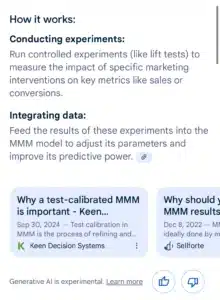
SEO and GEO writing: The skills to nail in 2025
What else can you do to future-proof your content team ahead of the evolving AI search landscape? Based on our exclusive research on B2B brands’ AI traffic, you can take a few extra steps to optimize content for generative search, too.
Discover the latest AI search trends
My two favorite key takeaways:
- AI sources don’t like flowery language
- AI sources like data points and rich media
The study findings felt like a validation of the type of writing my team is already doing. For example:
- Focusing on a simple, direct, factual and precise writing style
- Incorporating tables and images into blogs when we can
- Citing surveys or statistics in the text
And now, we’re more diligently following this best practice: adding key highlights to every piece we write. Why? They sum up the information, making the content more accessible (for readers and AI tools) and increasing its chances of ranking.
Let’s pave the future of branded content together
From AI disruption to potential algorithm shifts, 2025 won’t be a dull year. So if you’re a B2B SaaS brand looking to future-proof your content marketing efforts in 2025, and need an agency’s team to have your back, shoot us a message.
As a growth consultancy, we help technology companies leverage SEO and GEO-optimized content to build thought leadership, generate leads and boost sales. We’re based in Toronto but our content writing clients span major tech hubs from San Francisco and Seattle to Austin and New York.
And as I tell any writer or content strategist interviewing for a role with us, we’re in the big leagues. If you’re at the top of your game and looking for an opportunity to join a content team obsessed with high-quality writing and the coolest projects, apply, too.
Whether you’re a B2B SaaS company or a talented writer, come lead the way with us.
Frequently asked questions
What is the future of content marketing?
The future of content marketing is AI-powered and data-driven with brands leveraging automation, interactive formats, and immersive experiences to engage audiences across different platforms.
💡 Keep learning: The CMO’s first 90 days: A playbook for SaaS leaders
What is the role of a content team?
The role of a content team is to create and deliver high-quality, engaging content that aligns with a company’s marketing goals and resonates with its target audience.
Responsibilities in a content marketing team include:
- Developing a content strategy that outlines the target audience, content formats, editorial calendar, distribution channels and key performance indicators (KPIs)
- Producing different types of content, such as blogs, white papers, internal documentation, newsletters, website copy, social media posts, video content, infographics and more
- Optimizing content for search engines and AI sources to maximize visibility and reach
- Sharing pieces of content across relevant channels, including websites, social media platforms, email newsletters and other platforms
- Tracking content performance, analyzing data and generating insights to improve future content strategy and creation efforts
💡 Keep learning: Our proven B2B SaaS content writing process
What are AI patterns in writing?
AI patterns in writing refer to the stylistic and structural tendencies of AI-generated text, as being repetitive, unoriginal and generic. The reason? AI models:
- Often over-rely on certain phrases or sentence structures
- Generate text based on patterns in its training data, which can result in content that lacks unique insights, perspective, and substance
🤖 Learn how to avoid AI writing patterns
Why are AI patterns bad for SEO?
AI patterns can negatively impact SEO because search engines like Google prioritize high-quality, original content that provides value to users. Plus, AI tools need new content to improve their output. If AI models are primarily trained on existing and potentially even AI-generated content, they risk perpetuating similar patterns and themes.
AI patterns often:
- Lack originality: Search engines may penalize content that is too similar to other content on the web.
- Lead to poor user experience: Repetitive, generic or surface-level content may cause visitors to leave your site quickly — a signal to search engines that your content is not useful.




